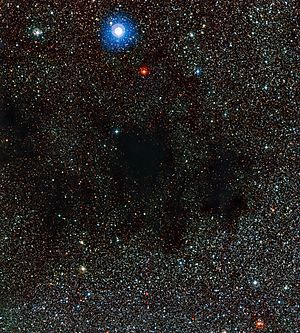Coalsack Nebula facts for kids
| Dark nebula | |
|---|---|

The Coalsack Nebula taken by the Wide Field Imager on the MPG/ESO 2.2-metre telescope
|
|
| Observation data: J2000.0 epoch | |
| Right ascension | 12h 50m |
| Declination | −62° 30′ |
| Distance | 180 pc |
| Apparent magnitude (V) | – |
| Apparent dimensions (V) | 7° × 5° |
| Constellation | Crux |
| Physical characteristics | |
| Radius | 30–35 ly |
| Absolute magnitude (V) | – |
| Notable features | – |
| Designations | Caldwell 99 |
The Coalsack Nebula (also called the Southern Coalsack) is a special kind of cloud in space. It is known as a dark nebula. This means it is a cloud of dust and gas that blocks light from stars behind it.
You can see the Coalsack Nebula with your naked eye (without a telescope!). It looks like a big, dark patch in the sky. It blocks out part of the Milky Way galaxy. Look for it near the bright star Acrux in the Crux constellation. Crux is also known as the Southern Cross.
Contents
Discovering the Coalsack Nebula
For a long time, any dark cloud in the night sky was sometimes called a "coalsack." But in 1899, a scientist named Richard Hinckley Allen gave the name "Coalsack Nebula" to this specific dark cloud. He also named another one the Northern Coalsack Nebula.
The Coalsack Nebula is quite large. It covers an area of about 7 degrees by 5 degrees in the sky. It even stretches into the nearby constellations of Centaurus and Musca.
The first time someone wrote about seeing the Coalsack Nebula was in 1499. This was reported by Vicente Yáñez Pinzón. Later, Amerigo Vespucci called it "il Canopo fosco" (the dark Canopus). It was also known as "Macula Magellani" (Magellan's Spot) or the "Black Magellanic Cloud." People gave it these names because it looked like a dark version of the bright Magellanic Clouds.
The Coalsack in Ancient Cultures

Many ancient cultures had special ways of looking at the stars. They often saw shapes and stories in the sky.
Australian Aboriginal Astronomy
In Australian Aboriginal astronomy, the Coalsack Nebula is very important. It forms the head of the emu in the sky. This "emu" is a special constellation made from dark clouds, not bright stars.
Among the Wardaman people, the Coalsack is seen as the head and shoulders of a "law-man." This law-man watches over people to make sure they follow traditional laws. One legend says this being is called Utdjungon. If people did not follow the tribal law, Utdjungon might destroy the world with a fiery star.
There are also stories that connect the Coalsack to special ceremonial grounds on Earth called bora rings. These sky sites allowed spirits to continue ceremonies, just like people do on Earth. Since bora grounds often point north–south, the southern Coalsack marks a ceremonial ring in the sky.
Inca Astronomy
The Inca people also had their own names for the Coalsack Nebula. In their astronomy, this dark cloud was called Yutu. This name comes from a bird that looks like a partridge, found in South America. This bird is also known as a Tinamou.
Images for kids
-
A depiction of the emu in the sky. This is an Australian Aboriginal constellation made of dark clouds, not stars. The European constellation on the right is Crux, or the Southern Cross. On the left is Scorpius. The head of the emu is the Coalsack.
See also
 In Spanish: Nebulosa Saco de Carbón para niños
In Spanish: Nebulosa Saco de Carbón para niños

